Landscape and Urban Governance: Participatory Planning of the Public Realm in Saida, Lebanon
Abstract
:1. Introduction
1.1. Why Participatory Planning?
1.2. The Political Landscape of Lebanon
1.3. A Landscape Framing of a Participatory Approach
2. Materials and Methods: Saida Case Study
2.1. Case Study Method in Landscape Architecture
2.2. Saida City Profile
2.3. MedCities City Development Strategy
3. Application of a Participatory Approach
“The team adopted an institutional perspective in which participatory democracy plays an essential role. Participatory democracy is a process of deliberation based on effective cooperation between the various institutions in the city, via the creation of institutional networks that exchange information, knowledge, and experience between the municipality and the socio-economic actors in the city.”[19]
4. Discussion
5. Conclusions
Author Contributions
Conflicts of Interest
References
- Oxhorn, P. Civil society without a State? Transnational civil society and the challenge of democracy in a globalizing world. World Future 2007, 63, 324–339. [Google Scholar] [CrossRef]
- Oxhorn, P.; Tulchin, J.; Selee, A. Decentralization, Democratic Governance, and Civil Society in Comparative Perspective. Africa, Asia and Latin America; John Hopkins University Press: Baltimore, MD, USA, 2004. [Google Scholar]
- Prachett, L.; Wilson, D. Local Government under Siege. In Local Democracy and Local Government; Prachett, L., Wilson, D., Eds.; Macmillan Press Ltd.: London, UK, 1996; pp. 1–19. [Google Scholar]
- Pierre, J. Public-Private Partnerships and Urban Governance: Introduction. In Decentralization, Democratic Governance, and Civil Society in Comparative Perspective Africa, Asia and Latin America; Oxhorn, P., Tulchin, J., Selee, A., Eds.; John Hopkins University Press: Baltimore, MD, USA, 1997; pp. 1–10. [Google Scholar]
- Stoker, G. Public-Private Partnerships and Urban Governance. In Urban Governance; Pierre, J., Ed.; Partnerships, Palgrave Macmillan: London, UK, 1998; pp. 34–51. [Google Scholar]
- UNHabitat, Governance. Available online: https://unhabitat.org/governance/ (accessed on 27 September 2017).
- McEwan, C. Bringing government to the people: Women, local governance and community participation in South Africa. Geoforum 2003, 34, 469–481. [Google Scholar] [CrossRef]
- Williams, G. Evaluating participatory development: Tyranny, power and (re)politicization. Third World Q. 2004, 25, 557–579. [Google Scholar] [CrossRef]
- Participation Research Cluster. Participatory Methods. Available online: http://www.participatorymethods.org/ (accessed on 27 September 2017).
- Council for Development and Reconstruction, National Physical Master Plan of the Lebanese Territories. 2005. Available online: http://www.cdr.gov.lb/study/sdatl/sdatle.htm (accessed on 1 January 2018).
- Makhzoumi, J. The greening discourse: Ecological landscape design and city regions in the Mashreq. In Reconceptualizing Boundaries: Urban Design in the Arab World; Saliba, R., Ed.; Ashgate: London, UK, 2015; pp. 63–80. [Google Scholar]
- Egoz, S.; Makhzoumi, J.; Pungetti, G. The Right to Landscape: Contesting Landscape and Human Rights; Ashgate: London, UK, 2011. [Google Scholar]
- Olwig, K. Landscape, Nature and the Body Politic; University of Wisconsin Press: Madison, WI, USA, 2002. [Google Scholar]
- Egoz, S.; Jorgensen, K.; Ruggeri, D. Defining Landscape Democracy; Edward Elgar Publishing: London, UK, 2018. [Google Scholar]
- Wall, E.; Waterman, T. Landscape and Agency: Critical Essays; Routledge: London, UK, 2018. [Google Scholar]
- Gillham, B. Case Study Research Methods; Bloomsbury Publishing: London, UK, 2010. [Google Scholar]
- Francis, M. A Case Study Method for Landscape Architecture; Landscape Architecture Foundation: Washington, DC, USA, 1999; Available online: https://lafoundation.org/myos/my-uploads/2010/08/19/casestudymethod.pdf (accessed on 12 February 2018).
- Makhzoumi, J. Landscape in the Middle East: An inquiry. Landsc. Res. 2002, 27, 213–228. [Google Scholar] [CrossRef]
- Chaaban, J.; Srour, I.; Hamadeh, K. Saida USUDS Strategic Diagnosis: Institutional and Legal Framework. 2014. Available online: http://www.medcities.org/documents/22116/135803/5.+Saida_Diagnosis+_+Institutional+and+Legal++Framework.pdf/b62f3b3a-53aa-41d8-bdbf-4fccbe2d4114 (accessed on 2 January 2018).
- MedCities. Available online: http://www.medcities.org/ (accessed on 31 December 2017).
- MedCities Saida CDS. Available online: http://www.medcities.org/web/saida (accessed on 2 January 2018).
- Makhzoumi, J.; Pungetti, G. Ecological Design and Planning: The Mediterranean Context; E. & F. N. Spon, Routledge: London, UK, 1999. [Google Scholar]
- Makhzoumi, J.; Al-Sabbagh, S. Saida USUDS Strategic Diagnosis: Green Open Spaces. 2014. Available online: http://www.medcities.org/documents/22116/135803/2.+Saida_Diagnosis_Green-Open.pdf/4bbf1534-8be5-46b1-b2ea-1b30f477d27d (accessed on 2 January 2018).
- Al-Sabbagh, S. Rethinking Planning Tools through the Ecological Landscape Design Approach: Saida Case Study. Master’s Thesis, Urban Design, American University of Beirut, Beirut, Lebanon, February 2015. [Google Scholar]
- Lil, M. Qamleh River in Greater Saida: Its Disappearance and Efforts to Revive it; Creative Commons: Saida, Lebanon, 2017. (In Arabic) [Google Scholar]
- De Soto, H. The Other Path, The Economic Answer to Terrorism; Basic Books: New York, NY, USA, 2002. [Google Scholar]
- De Soto, H. The Mystery of Capital: Why Capitalism Triumphs in the West and Fails Everywhere Else; Basic Books: New York, NY, USA, 2000. [Google Scholar]
- Makhzoumi, J. Landscape architecture and the discourse on democracy in the Middle East. In Defining Landscape Democracy; Egoz, S., Jorgensen, K., Ruggeri, D., Eds.; Edward Elgar Publishing: London, UK, 2018. [Google Scholar]
| 1 | While ‘government’ refers to “the formal institutional structure and location of authoritative decision-making in the modern state”, ‘governance’ signifies new processes of governing and new methods by which society is governed, and a focus on the interdependence of governmental and non-governmental organizations working together [5] (p. 34). |
| 2 | UN-Habitat defines ‘governance’ as the many ways that institutions (i.e., local authorities) and individuals “organize the day-to-day management of a city, and the processes used for effectively realizing the short-term and long-term agenda of a city’s development” [6]. |
| 3 | With a total population of 149,600, Saida is the third largest city in Lebanon; 80,000 of Saida inhabitants are Lebanese; the rest, Palestinians. |
| 4 | The six project phases include: (1) Preparation and Launching; (2) Diagnosis and Participatory Analysis; (3) Formulation of a Shared Vision; (4) Strategy Formulation to Translate Vision into Concrete Actions; (5) Preparation of Action Plans and Estimated Budget; and (6) Implementation, Monitoring and CDS Evaluation [21]. |
| 5 | The members include: the deputy mayor, four municipal council members, vice president for the Saida Traders Association, Said Welfare Society, Director of the Sea Mosque Organization, executive director from the Hariri Foundation, General Manager of the Saida Chamber of Commerce, and representative from the Lebanese University. |
| 6 | Working Group members include: 13 participants for the Urban Infrastructure track; eight for the Landscape, Environment and Ecology track; 16 for Cultural and Natural Heritage; 12 for the Employment in Traditional Industries and Trades; 14 participants for the Institutional and Legal Framework track; and 10 for the Local Economic Development. |
| 7 | The second Town Hall Meeting was cancelled because of armed confrontation between political parties on the day, which escalated to engulf the city for the following weeks. |
| 8 | Project disciplinary tracks and their respective national expert(s): “Local Economic Development”, “Social Structure and Urban Governance”, Jad Chaaban, IIina Srour and Kanj Hamade; “Cultural Heritage” and team leader, Howayda AI Hanthy; “Urban Infrastructure”, Omar Abdulaziz Hallaj and Giulia Guadagnoli; “Landscape Environment and Ecology”, Jala Makhzoumi and Salwa Al-Sabbagh. |
| 9 | For a detailed description of the Saida Green-Blue Network refer to Saida USUDS Green Open Spaces [23]. |
| 10 | Al-Sabbagh builds on the Saida USUDS to explore the potential of an ecological landscape planning methodology to propose context-responsive and culture-inclusive planning tools to counter market-led, homogenizing, and exclusive development [24]. |
| 11 | Saida USUDS working group meetings. |
| 12 | ‘Train/Train’, https://www.facebook.com/traintrainlebanon/ a group aiming to reclaim the railway network in Lebanon as a public realm. The extensive railway network in Lebanon was abandoned in the 1970s during the civil war. The corridors and stations are state-owned, allowing for temporary amenity use. Another group was ‘Dictaphone’, civil activists with the aim of reclaiming the public realm; see http://www.dictaphonegroup.com/both accessed (1 January 2018). |
| 13 | In Arabic ‘Mamar’ implies passage, which has spatial dimensions and non-spatial connotations of a process that addresses issues of governance for Saida youth. |
| 14 | The activities organized for the project by ‘Shajar w Bashar’ include: meetings for civic empowerment, 2013; meetings with political stakeholders; launching the project, 28 March 2014; petition signing; ‘Walk/Cycle the Railway’, 12 April 2014; closing ceremony 26 June 2014. See https://www.peaceinsight.org/conflicts/lebanon/peacebuilding-organisations/shajar-w-bashar/ and https://arab.org/directory/shajar-w-bashar/. |
| 15 | Arabic ‘Lil Madina’ translates ‘for the city’, founded in 2013 by residents of Saida, mainly architects and urban designers. Their collective agenda, modus operandi, and outreach differs considerably from ‘Shajar w Bashar’. See https://lilmadinainitiative.wordpress.com/ (1 February 2018). |
| 16 | This article’s author, Sabbagh, participated in data gathering and field survey for the Qanaya study and was an active partner in many of the Lil Madina initiatives. |
| 17 | Workshops co-organized by Lilmadina and Al-Sabbagh include: “Development of East Wastani”, February 2014; Public and focused talks, i.e., Makassed Talk, May 2015; ‘Towards Improving the Land-Pooling and Subdivision Tool Roundtable in collaboration with Issam Fares Institute, 19 December 2015 co-organized with Sabbagh; “Developing Al-Qamleh Valley” April 2015. |
| 18 | The Lebanese urban planning framework applied by corporate land developers includes a set of regulatory (e.g., master plans, building law) and operational tools (e.g., land pooling tool) that is top-heavy, ignoring the specificity of place and local community. For a detailed discussion of the land pooling corporate application in the East Wastani project versus ecological guidelines for planning see Salwa Sabbagh, 2015 [24]. |
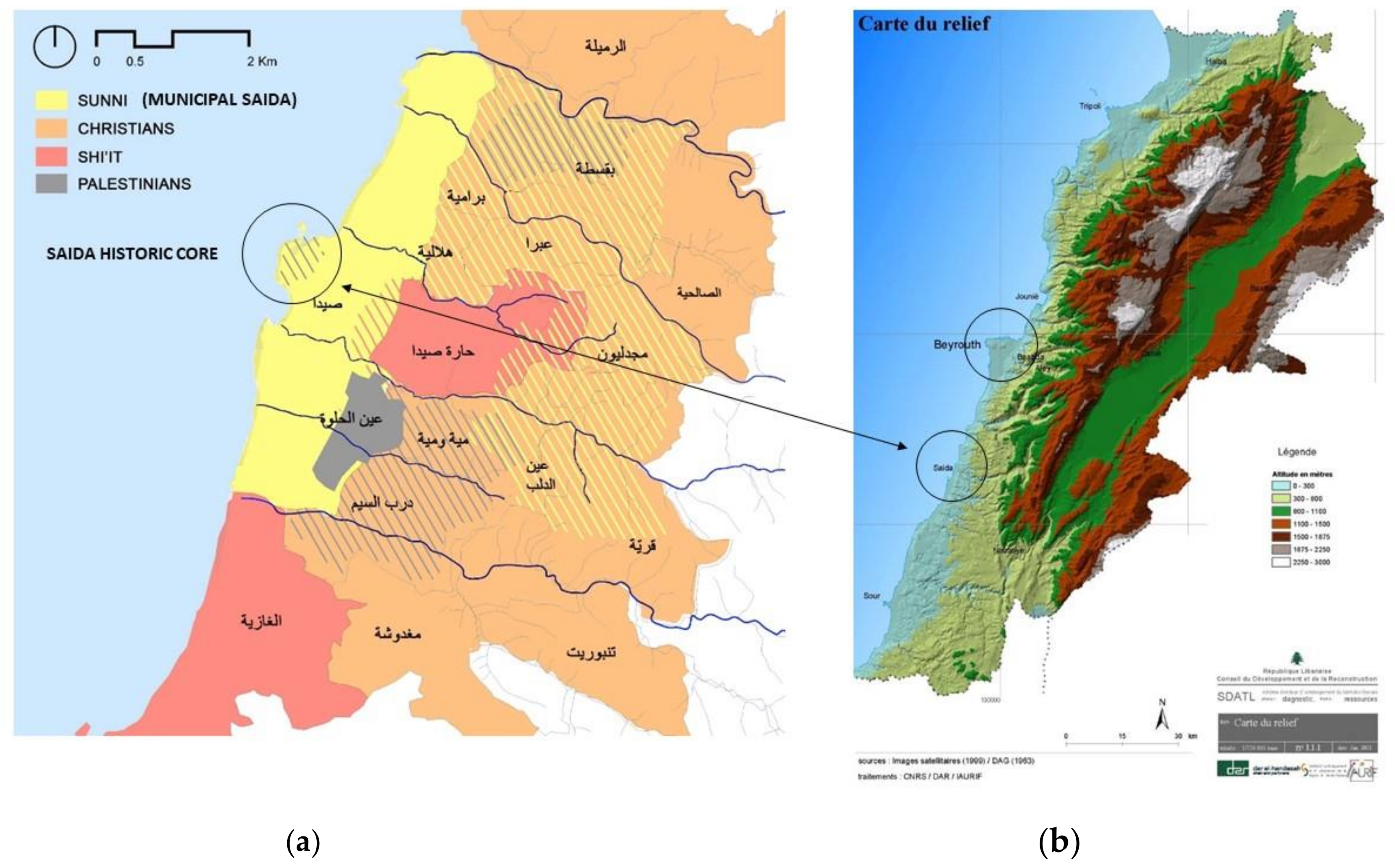
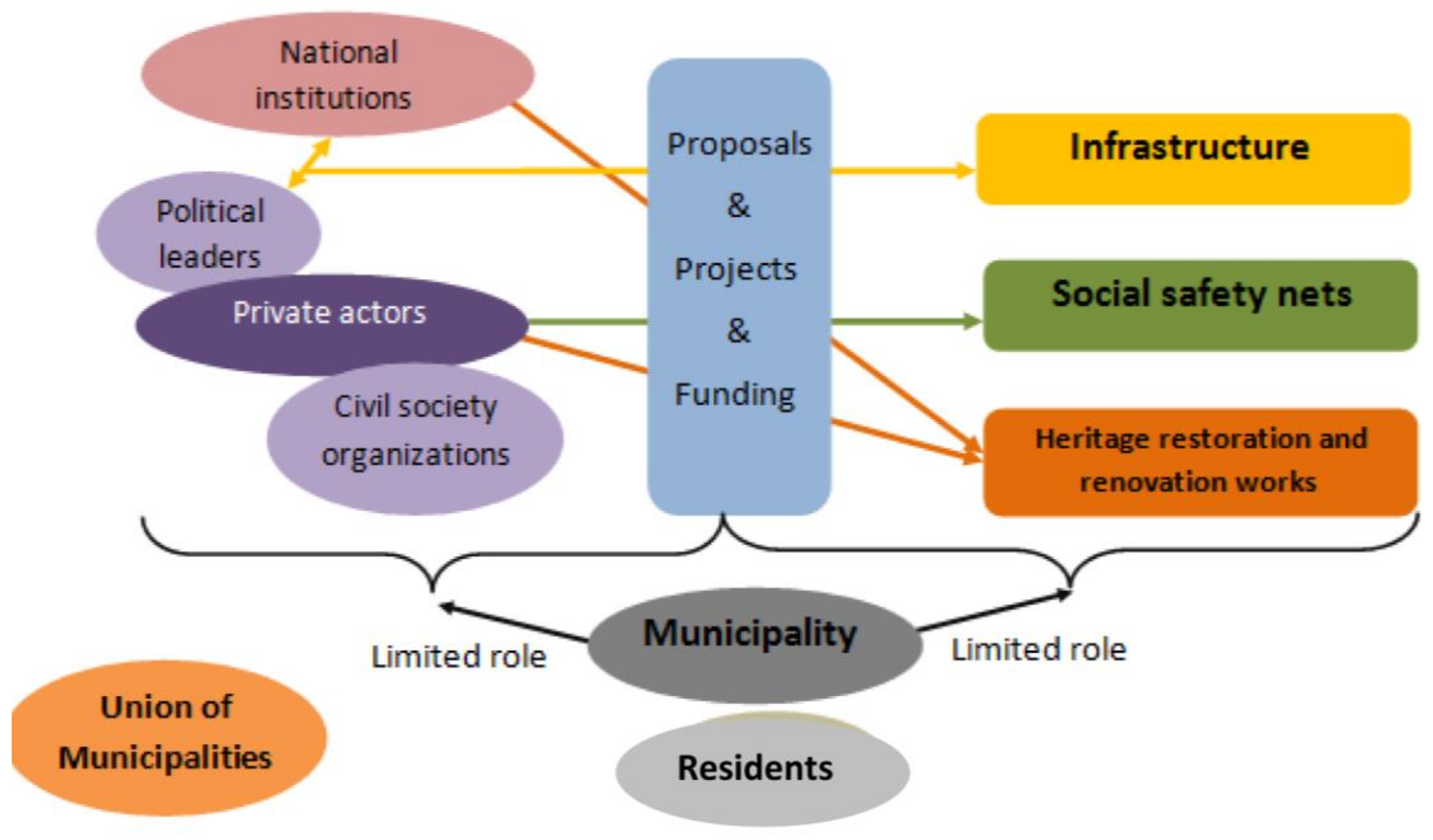
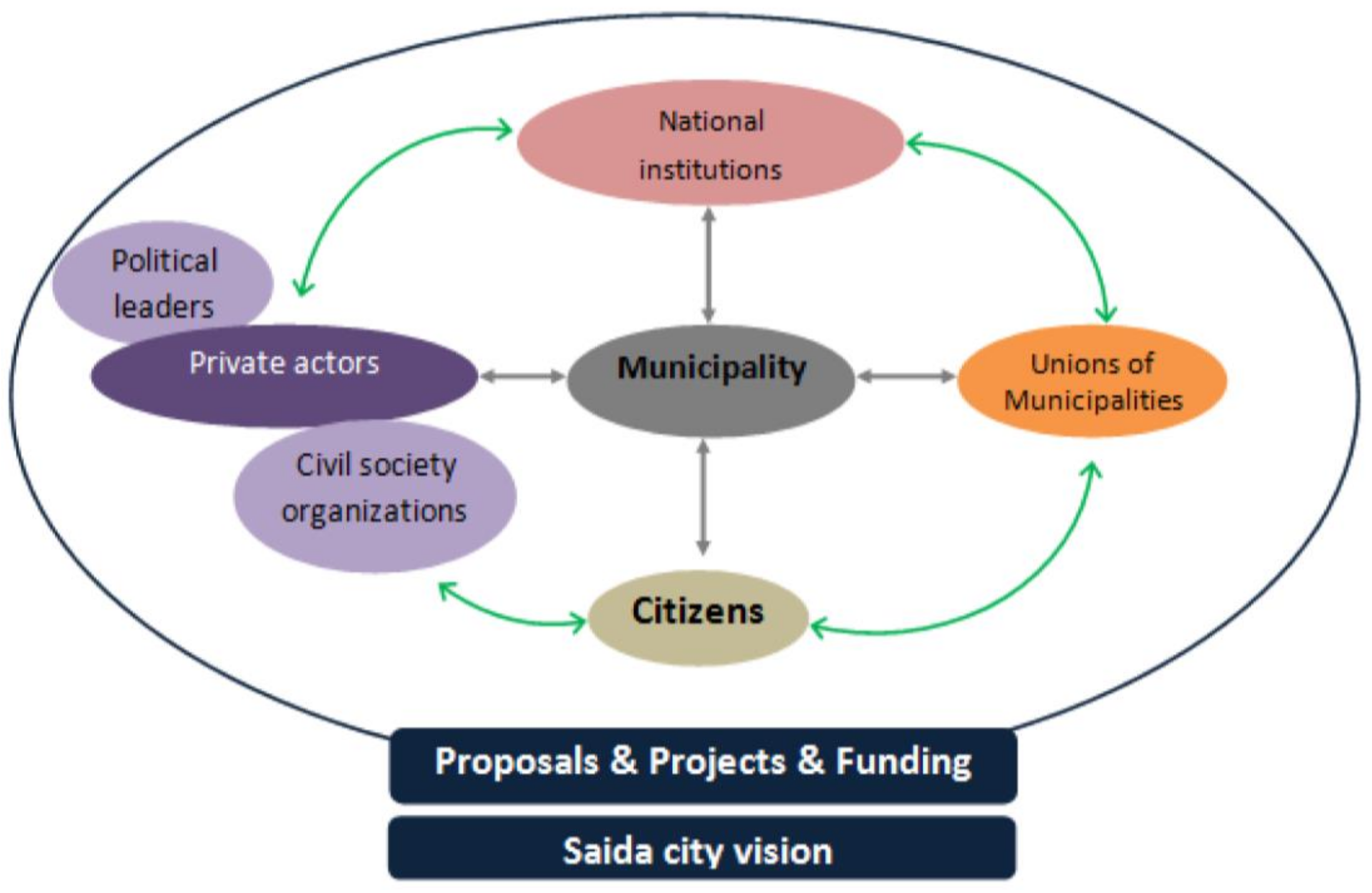
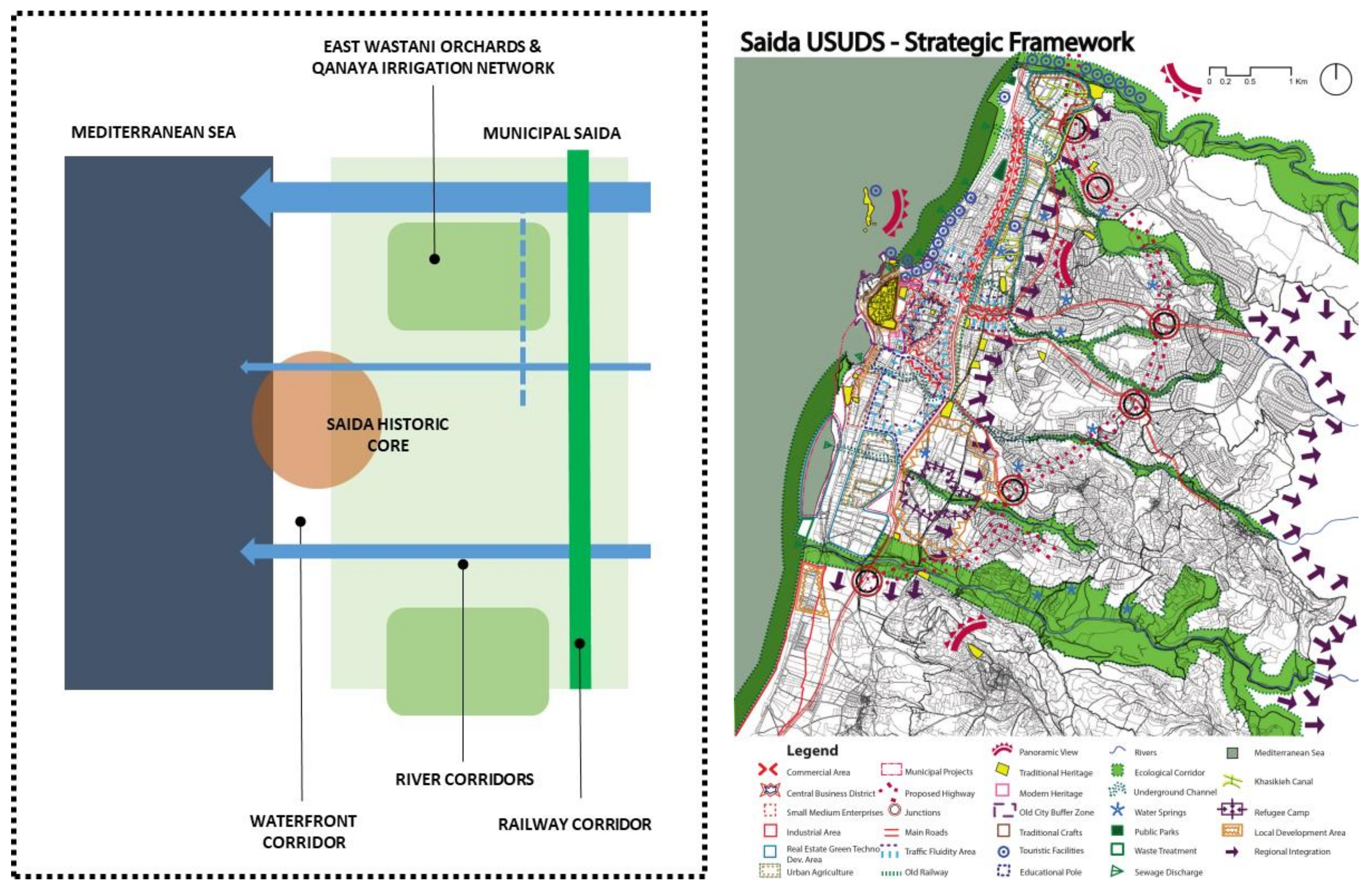
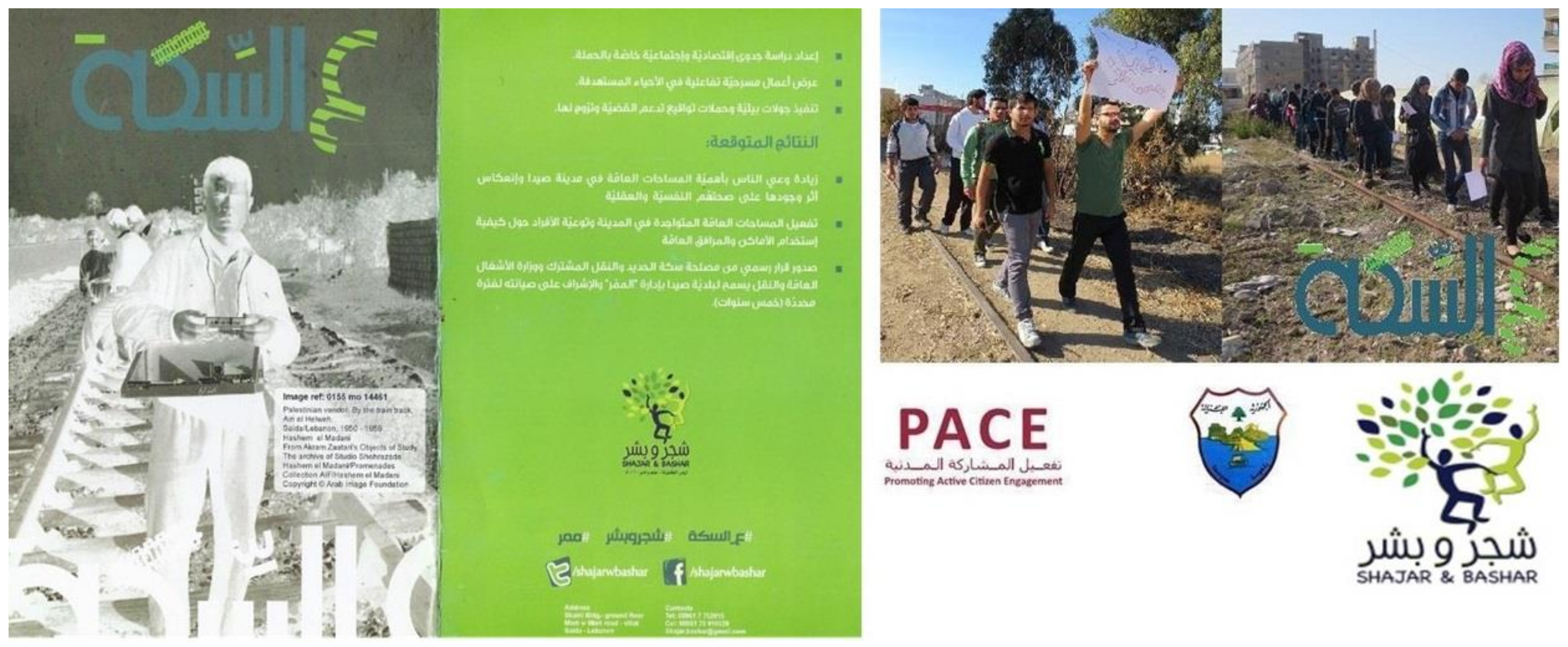
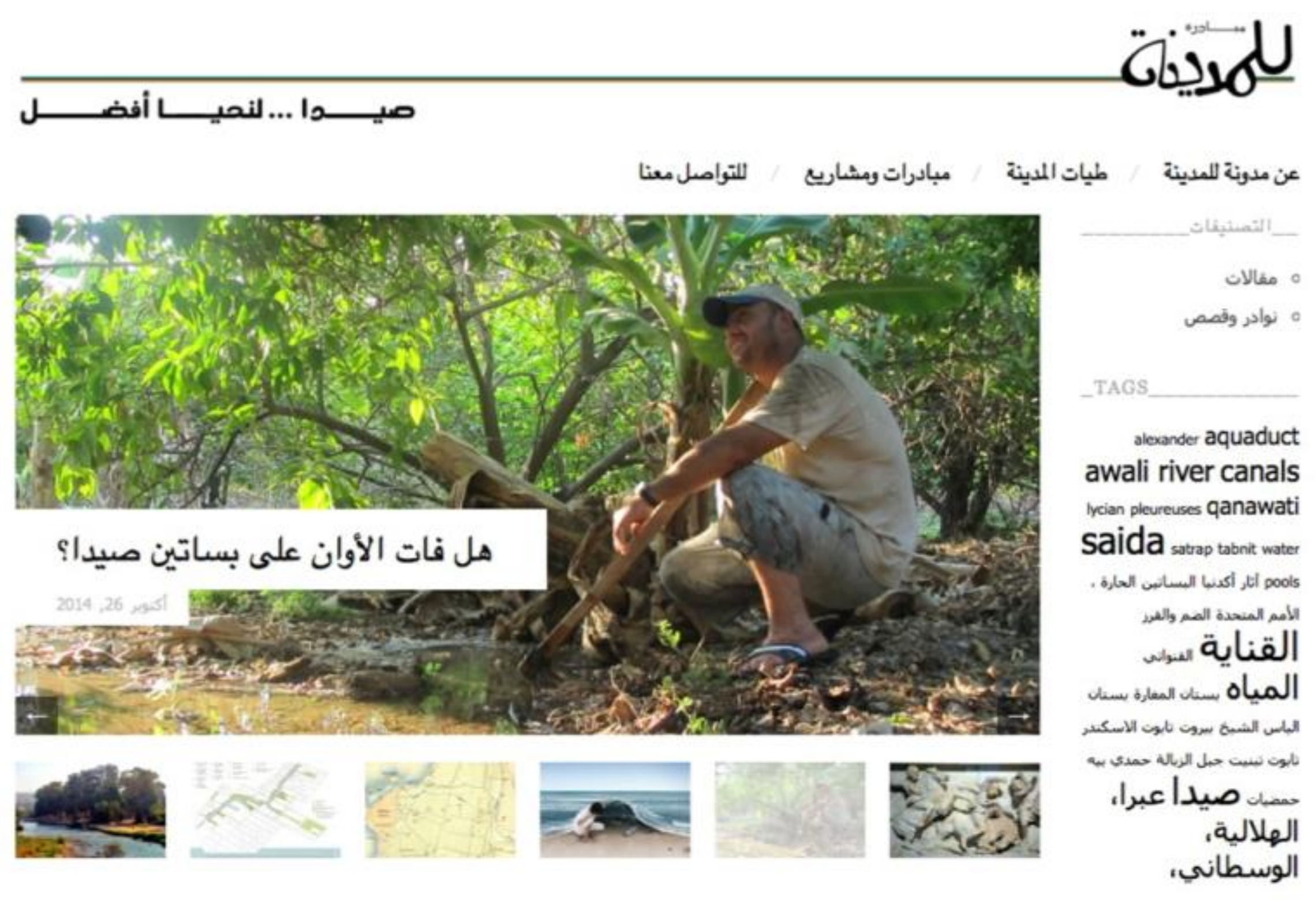
© 2018 by the authors. Licensee MDPI, Basel, Switzerland. This article is an open access article distributed under the terms and conditions of the Creative Commons Attribution (CC BY) license (http://creativecommons.org/licenses/by/4.0/).
Share and Cite
Makhzoumi, J.; Al-Sabbagh, S. Landscape and Urban Governance: Participatory Planning of the Public Realm in Saida, Lebanon. Land 2018, 7, 48. https://doi.org/10.3390/land7020048
Makhzoumi J, Al-Sabbagh S. Landscape and Urban Governance: Participatory Planning of the Public Realm in Saida, Lebanon. Land. 2018; 7(2):48. https://doi.org/10.3390/land7020048
Chicago/Turabian StyleMakhzoumi, Jala, and Salwa Al-Sabbagh. 2018. "Landscape and Urban Governance: Participatory Planning of the Public Realm in Saida, Lebanon" Land 7, no. 2: 48. https://doi.org/10.3390/land7020048
APA StyleMakhzoumi, J., & Al-Sabbagh, S. (2018). Landscape and Urban Governance: Participatory Planning of the Public Realm in Saida, Lebanon. Land, 7(2), 48. https://doi.org/10.3390/land7020048



